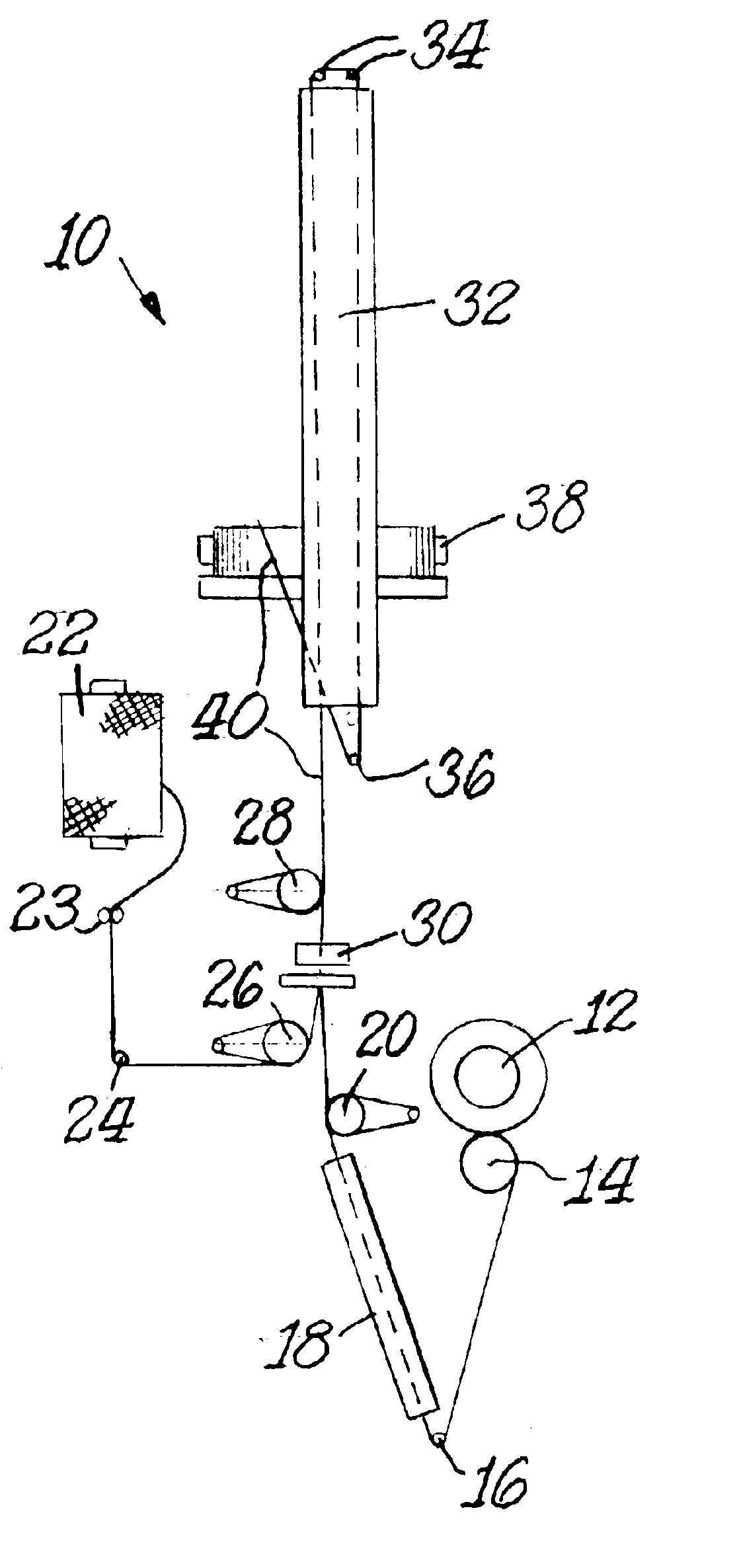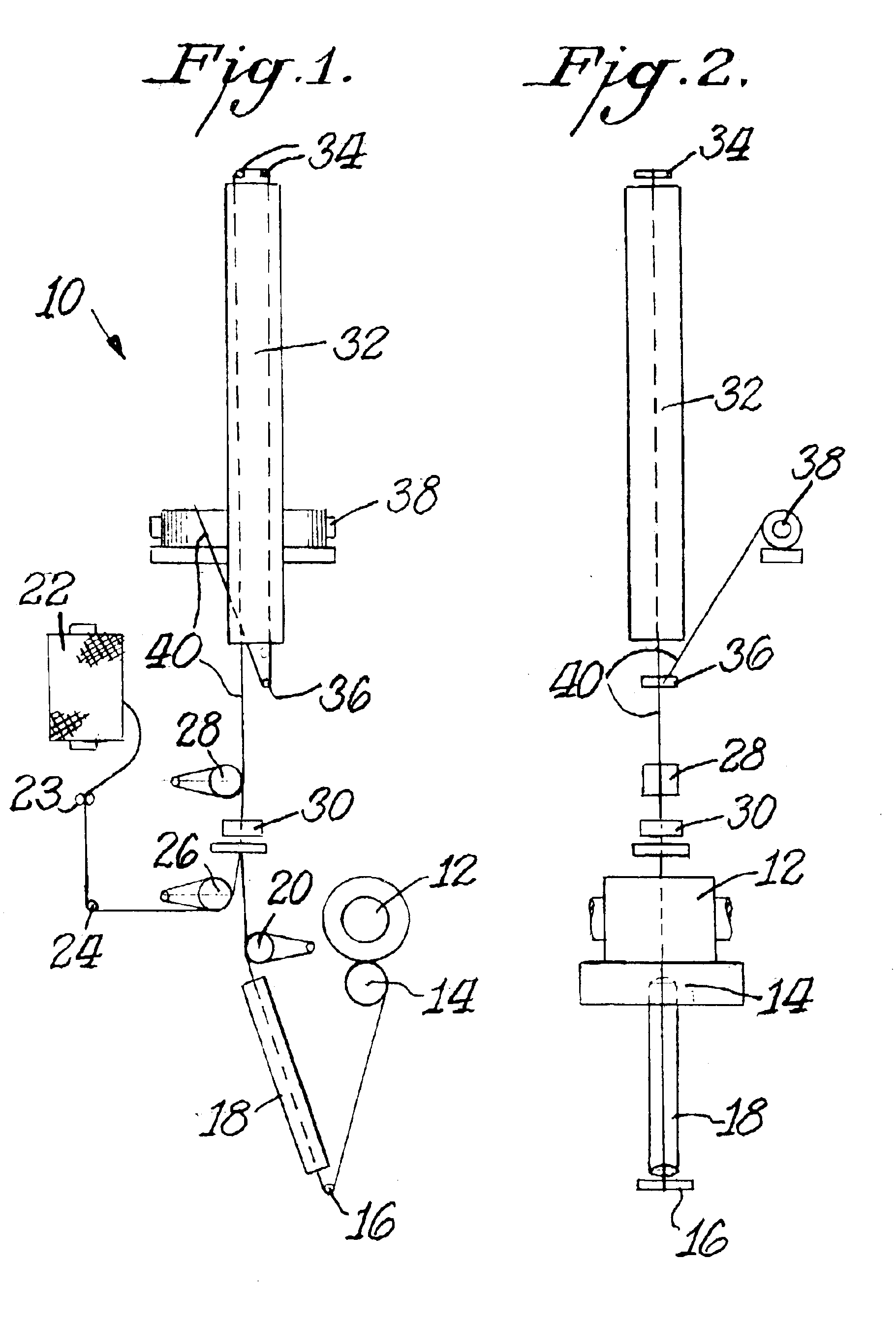Air-jet method for producing composite elastic yarns
a composite elastic and air-jet technology, applied in the field of elastic yarns, can solve the problems of increasing the likelihood of difficulties, ruined garments, adding further expense, etc., and achieves the effects of improving stitch clarity, good stitch quality, and enhancing results
- Summary
- Abstract
- Description
- Claims
- Application Information
AI Technical Summary
Benefits of technology
Problems solved by technology
Method used
Image
Examples
example 1
In this example hosiery knitted from yarns of the invention were directly compared to hosiery knitted from yarns of a standard air-jet covering process. Both processes were operated on the SSM machine at a wind-up speed of 400 meters / minute.
According to the first aspect of the invention, this example compares pantyhose properties opposite the control hose when pre-entanglement single-stage hot drafting in combination with post-entanglement heat-treatment is used. A 20-denier spandex is drawn to the same denier in the covered yarn as a 12 denier in the control hose, made from the standard AJC non heat-treated control yarn. Two examples are given, where the only variable used for the two heat-treated examples consists in the heater temperature used during the first drawing step (160° C. and 190° C.). Detailed process conditions and results are given in Table 2 below. “AJC” denotes “air-jet covering” or air-jet entangling.
TABLE 2AJCAJCWITH PRE - AndWITH PRE - AndAJC-POST HEAT-POST HEAT...
example 2
According to the second aspect of the invention, this example compares pantyhose properties opposite the control hose when two-stage pre-entanglement hot drafting in combination with post-entanglement heat-treatment is used (FIG. 3).
In the specific examples in Table 3 below, a 70-denier spandex is drawn (i) to about the same denier as a 20-denier spandex in the control (i.e., about 7.5 denier), and (ii) to a 10% lower denier than the control (i.e., about 6.7 denier).
TABLE 3AJCAJCWITH 2-STAGEWITH 2-STAGEPRE-PRE-TREATMENTTREATMENTANDANDAJC-POST HEAT-POST HEAT-VARIABLESCONTROLTREATMENTTREATMENTSpandex yarn specsTypeDry spun,SameSametype 1Denier207070# filaments255Nylon yarn specsCompositionNylon6.6SameSameDenier15SameSame# filaments7SameSameTexturedS + ZSameSameAJC machine settings (FIG.3)Wind-up speed400m / minSameSameRoll surface speed (roll 28)412m / minSameSameRoll surface speed (roll 26)424m / minSameSameRoll surface speed (roll 54)Not used412m / min412m / minRoll surface speed (roll 20)412...
example 3
In an alternate embodiment of the invention, the elastomeric yarn (e.g., spandex) is drafted at room temperature, with heating following the jet-entangling step. Detailed process conditions and results are set forth in Table 4. In this example, the spandex drafting is at room temperature, and at a machine draft of 2.6× for the inventive process and for the control.
TABLE 4AJC WITHAJC WITHAJC WITHPOST HEATPOST HEATPOST HEATTREATMENTTREATMENTTREATMENTVARIABLESAJC CONTROL(Invention)(Invention)(Invention)Spandex yarnspecsCompositionDry spun,SameSameSameType IDenier12SameSameSame# filaments1SameSameSameNylon yarn specsCompositionNylon6,6SameSameSameDenier15SameSameSame# filaments7SameSameSameTexturedS + ZSameSameSameAJC machinesettings (FIG. 1)Wind-up speed400m / min400m / min200m / min600m / minRoll surface speed412m / min408m / min204m / min612m / min(roll 28)Roll surface speed424m / min424m / min210m / min630m / min(roll 26)Roll surface speed412m / min408m / min204m / min612m / min(roll 20)Roll surface speed160m / min1...
PUM
| Property | Measurement | Unit |
|---|---|---|
| temperature | aaaaa | aaaaa |
| temperature | aaaaa | aaaaa |
| temperature | aaaaa | aaaaa |
Abstract
Description
Claims
Application Information
 Login to View More
Login to View More - R&D
- Intellectual Property
- Life Sciences
- Materials
- Tech Scout
- Unparalleled Data Quality
- Higher Quality Content
- 60% Fewer Hallucinations
Browse by: Latest US Patents, China's latest patents, Technical Efficacy Thesaurus, Application Domain, Technology Topic, Popular Technical Reports.
© 2025 PatSnap. All rights reserved.Legal|Privacy policy|Modern Slavery Act Transparency Statement|Sitemap|About US| Contact US: help@patsnap.com



